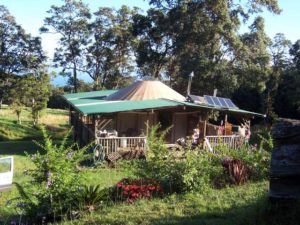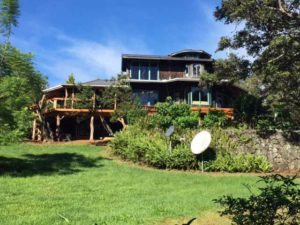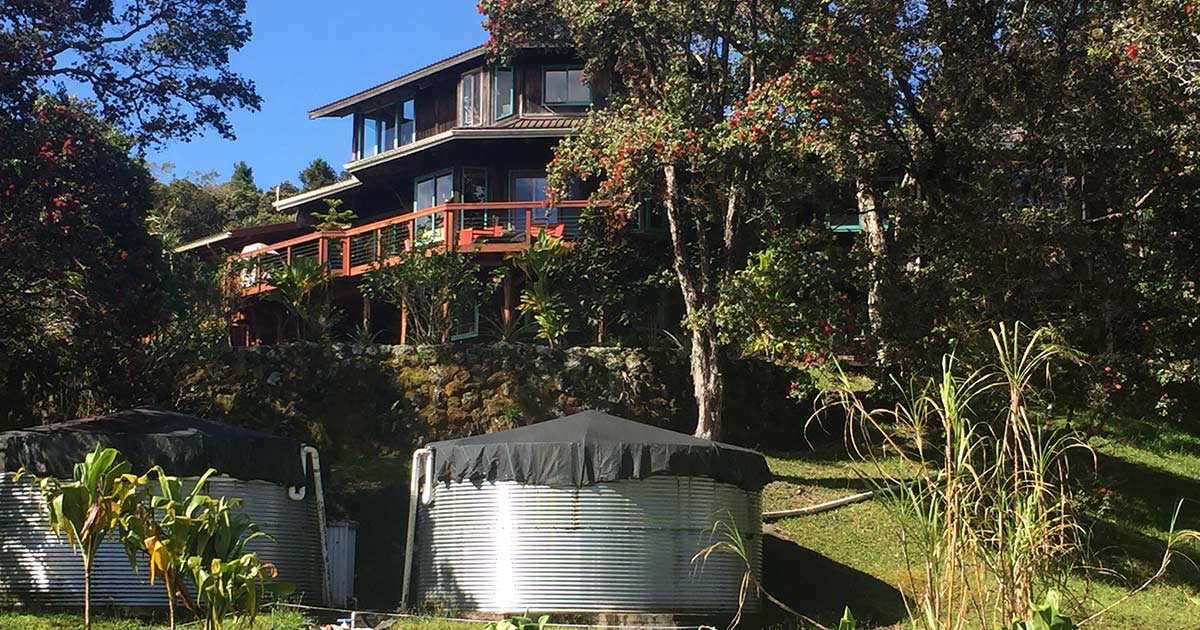Our biggest argument came over the use of the microwave oven. I have always had this convenience.
What does it take to live off-grid?
 When Pat and I moved to the Hamakua Coast, specifically into our rented yurt in Paauilo, we committed to a totally off-grid lifestyle. At that point, we had only experienced this type of lifestyle while staying a month on a friend’s 20-acre equestrian property in Hakalau (about 20 minutes outside Hilo). John showed us his “systems” and shared about the installation process and cost, maintenance, idiosyncrasies, benefits and challenges. We were able to see, first hand, how it all worked, and in the process decide IF this was a lifestyle we wanted to recreate when we finally were able to purchase our own home.
When Pat and I moved to the Hamakua Coast, specifically into our rented yurt in Paauilo, we committed to a totally off-grid lifestyle. At that point, we had only experienced this type of lifestyle while staying a month on a friend’s 20-acre equestrian property in Hakalau (about 20 minutes outside Hilo). John showed us his “systems” and shared about the installation process and cost, maintenance, idiosyncrasies, benefits and challenges. We were able to see, first hand, how it all worked, and in the process decide IF this was a lifestyle we wanted to recreate when we finally were able to purchase our own home.
 Our temporary dwelling was a rented yurt nestled in the ohia forest of Paauilo, at the upper end of the Hamakua Coast. Set on 12 beautiful acres, with a partial ocean view, we experienced the realities of no public or private utilities. Pat was a quick study, and soon had a good handle on understanding how each system worked, maintaining them, and monitoring our usage. (This is where the rub came in for me. More on that a bit later.) Then, fourteen months after moving into the yurt we moved out and into our own home, also off-grid, also in Paauilo. It was a fixer upper in more ways than one. Pat insisted that we bring all the systems up to functioning capacity. That included a new roof, gutters, water catchment and solar. I was more concerned with new carpet and refinishing the floors. We both won.
Our temporary dwelling was a rented yurt nestled in the ohia forest of Paauilo, at the upper end of the Hamakua Coast. Set on 12 beautiful acres, with a partial ocean view, we experienced the realities of no public or private utilities. Pat was a quick study, and soon had a good handle on understanding how each system worked, maintaining them, and monitoring our usage. (This is where the rub came in for me. More on that a bit later.) Then, fourteen months after moving into the yurt we moved out and into our own home, also off-grid, also in Paauilo. It was a fixer upper in more ways than one. Pat insisted that we bring all the systems up to functioning capacity. That included a new roof, gutters, water catchment and solar. I was more concerned with new carpet and refinishing the floors. We both won.
Understanding the “Systems”
Water Catchment
Let’s talk about water and water catchment. I am a native Southern California gal. I turned on the water faucet and, voila, water came out. I gave zero thought as to how it got to my sink, tub, shower or toilet. I never had to think about IF it would get there, nor treating it or preserving it. Naughty me! When you live off-grid, either fully or in part, you must catch your water from the rain that falls. Basically, it lands on your roof, spills into your gutters and down spouts, and funnels into pipes that take it into your catchment tanks. Then, if your system is not gravity fed, a pump sends it through filters and into your home. When it finally comes out your faucets you can enjoy the freshest, cleanest water you have ever experienced!

Maintenance basically means occasionally cleaning your gutters, possibly “vacuuming” the interior of your covered catchment tank(s), and changing the filters as required. If you live in an area that gets ample rain, you should never have to worry about water again! Catchment tanks come in a multitude of sizes, from 300 gallon tanks that are perfect for your livestock areas, to 2500 gallons up to 10,000 gallons and even larger. And for those catchment tanks that service areas away from the home, such as livestock or garden areas, you build a roof over the tank, add the gutters and downspouts, then use the water as needed. And it will usually spill over and water your grass.
Solar
Let’s talk about solar power. Solar power for your electrical needs works great as long as you live in an area that gets decent sunshine. Certain areas of the island are challenged in this area, but most areas are able to support this off-grid system. And, your installer will recommend the number of panels needed for your amount of sunshine and needs. Solar panels are placed on your roof, and can also be placed on a ground mount. They must be property positioned to gather as much from the sun as possible each day. The power goes into batteries and is then stored for use. If you run out of stored power, you can use a generator that will give you the extra power you need. Be sure to purchase a generator that includes a remote on/off switch so you don’t have to head to the generator shed in the middle of the night, possibly in a rainstorm just to turn the darn thing on. Pat did that once and ended up toppling backwards down our slope! He wasn’t a pretty site when he came back into the house.
Setting yourself up for solar power is not cheap. But, once it is paid off you have very little expense in powering your home. We purchase used submarine batteries to save money, but there is ever changing new technology which increases the longevity and efficiency of manufactured solar batteries. This is the biggest repeat expense, about every 8 to 12 years.
And what about connecting to the internet, phone and TV? This is where satellite comes in. There are a number of satellite companies on the island, both for cell and TV, able to connect you to the world. In our case, we had to add a booster on our roof, both at the yurt and our new home, so we could get a stronger connection for our cell phones. And depending on what part of the island you inhabit, may determine which company you go with for your phone service. AT&T and Verizon are the two strongest signals. Streaming can be a real challenge. So, instead of Netflix movies streamed through our TV, we get the CD’s in our post office box. So old fashioned, but it works like a charm.
Did I mention propane? A large percentage of home owners have a propane tank somewhere on the property. In our case, we use propane for our flash water heaters (2), as well as our gas stove. Hawaii Gas comes two or three times a year, fills up the tank, sends us the bill, and we are good to go!
Cesspool, septic, county sewer…or composting?
Decades ago everyone had a cesspool. As subdivisions were constructed, septic became the norm. And, if you live in a more populated area, you are connected to the county sewer system. For us, we still have a cesspool, conveniently located a football field down the hill and under a huge piece of cement! Access is almost impossible, so we basically baby the system. No excessive TP down our toilets. If it’s brown, flush it down with a small amount of TP. And NO wipes or personal hygiene products of any kind! When visitors come, they get Potty Policy 101 in writing! And, we monitor it carefully. If this system poops out (pardon the pun) we are up the creek without a paddle!
If you truly want to go off-grid, you can consider one of the new handy-dandy composting toilets. I saw the newest models at the Tiny House Jamboree in Arlington, Texas when I was a guest speaker promoting my book. It is amazing to learn the benefits of this type of system as you consider the footprint of your property and home.
An important note: In Hawaii, all properties will be required to switch from cesspool to septic by 2050. All properties! And it is no longer legal to install a cesspool.
The pluses and minuses of off-grid living…in my opinion.
Solar
We have dear friends who live in Kalopa, a tiny community on the Hamakua Coast. When they were planning to build their home, and deciding how they would structure their systems, the wife decided she would not live off-grid. In hind-sight, she said she just didn’t understand how it all worked, and was concerned that she wouldn’t have what she needed when she needed it. I totally get that!
Pat is somewhat like the Gestapo in monitoring our power. He watches it like a hawk, basically to make sure we have power when we need it while not over-loading the system and causing our batteries to die prematurely. That is a very costly replacement expense. Our biggest argument came over the use of the microwave oven. I have always had this convenience. But, when we moved off-grid the rule was “Only use it between 10:00 am and 2:00 pm,” when the system is capturing power from the sun. Well, that wasn’t when I needed the microwave. I needed it first thing in the morning for breakfast, and later in the day while preparing dinner. Same with the toaster. And the argument often reoccurred when I needed to use the washer/dryer and vacuum cleaner. It got so bad with the microwave that we ended up giving it to our son. I just couldn’t take the repetitive arguments. Things are much more peaceful now. I have learned to use the stovetop, oven, or go without!
Also, I am a lover and collector of lamps. Most are vintage picked up from an antique store somewhere in the country. (Not counting my crystal Waterford lamp, of course.) I love lighting and feel that it really sets a nice mood in your home at night. When you live off-grid you can forget about turning on all those beautiful lamps! (Unless you have at least 24 to 32 solar panels installed.) Basically, you move from room to room, turning one off as you turn another on. With this in mind, I have nightlights in specific rooms so I don’t trip going up or down our small number of stairs that lead us into or out of our living room and master bedroom. This has probably been the toughest adjustment for me. Pat? He could care less, willing to feel his way around. Hmmmm
Wastewater
It took me a while to remember to throw the gently used TP into the trash can rather than down the toilet. And, to use a little rather than a wad. Now, I find myself doing the same thing while visiting family and friends on the mainland. I guess I have become a creature of habit…a good habit. And I am happy to report that, after almost eight years, we have had no issues with our cesspool.
Water Catchment
From a water standpoint, we have all we could possibly need. Our two 10,000 gallon catchment tanks, and the system set up as described above, works like a charm. It took us a while to realize that when our water pressure goes down it’s time to change the filter(s). And, after almost eight years, it is finally time to “vacuum” the inside of the tanks, specifically the bottom to remove small sediment build-up. We will hire a company to handle that.
Internet & Phone
Streaming a movie or something on Youtube can be a real challenge. We are still investigating a way to make that work. But, at the moment, we have to live without it. I have to say it doesn’t really bother me. I’m a Baby Boomer.
Is off-grid living for you?
Only you can make that decision. It may be your only choice depending on the area you choose to live. If it is a choice, decide if you are willing to put up with a bit of inconvenience to save money and use more of what is naturally provided rather than man-made. I find that I like the challenge of using less. That less is actually more. And that saving money in this area provides us with more money for other things. Don’t forget…we bought a fixer upper!


